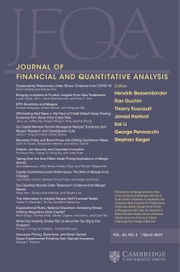No CrossRef data available.
Article contents
The Epidemiology of Financial Constraints and Corporate Investment
Published online by Cambridge University Press: 07 April 2025
Abstract
We show that a firm’s financial constraints trigger investment disruptions that propagate through the production network. Propagation effects account for about half of the total investment reduction due to constraints. Network rigidities such as high input specificity and the scarcity of alternative partners amplify these spillovers. Firms mitigate investment disruptions by supporting constrained partners through trade credit or equity stakes. To bolster identification, we employ a Network Regression Discontinuity Design that accounts for spillovers. Our estimates are robust to network measurement error, endogenous selection, and various constraint measures. The results demonstrate that interdependent investments amplify the consequences of capital-market frictions.
Information
- Type
- Research Article
- Information
- Creative Commons
- This is an Open Access article, distributed under the terms of the Creative Commons Attribution licence (http://creativecommons.org/licenses/by/4.0), which permits unrestricted re-use, distribution and reproduction, provided the original article is properly cited.
- Copyright
- © The Author(s), 2025. Published by Cambridge University Press on behalf of the Michael G. Foster School of Business, University of Washington
Footnotes
We are grateful for the helpful comments from Kenneth Ahern, Sam Antill (discussant), Rudy Araujo, Tobias Berg, Audra Boone, Celso Brunetti, Alex Butler, David Dicks, Winston Dou (discussant), Cesare Fracassi, Laurent Fresard, Paul Goldsmith-Pinkham, Charlie Hadlock, Jeff Harris, Robert Hauswald, Jerry Hoberg, Sabrina Howell, Paul Irvine, Shane Johnson (discussant), Travis Johnson, James LeSage, Xiaodong Liu (discussant), Zack Liu, Vojislav Maksimovic, Gonzalo Maturana, Greg Nini, Clemens Otto (discussant), Joshua Pierce (discussant), Ali Sanati, Shri Santosh, Christoph Schiller (discussant), Geoff Tate, Sheridan Titman, Toni Whited, Eddie Wei (discussant), Adam Winegar, and Jeff Wooldridge, as well as seminar participants at American University, Bank of Canada, Baylor University, BI Norwegian School of Business, 2024 Cavalcade, Colorado State University, 2024 FIRS, Georgetown University, University of Maryland, University of Texas at Austin, University of Western Ontario, Virginia Tech, 2022 Finance Organizations and Markets, 2021 Lone Star Finance Symposium, 2022 Midwest Finance Association, 2022 Southern Finance Association, 2022 Western Finance Association, and the 2nd Annual DC Juniors Finance Conference. We are especially thankful to Gary Cornwall and Beau Sauley for sharing code, to Laurent Frésard, Gerard Hoberg, and Gordon Phillips for sharing VTNIC data, and to Greg Nini, David Smith, and Amir Sufi for providing an extended sample of loan covenant violations. All errors are our own.

